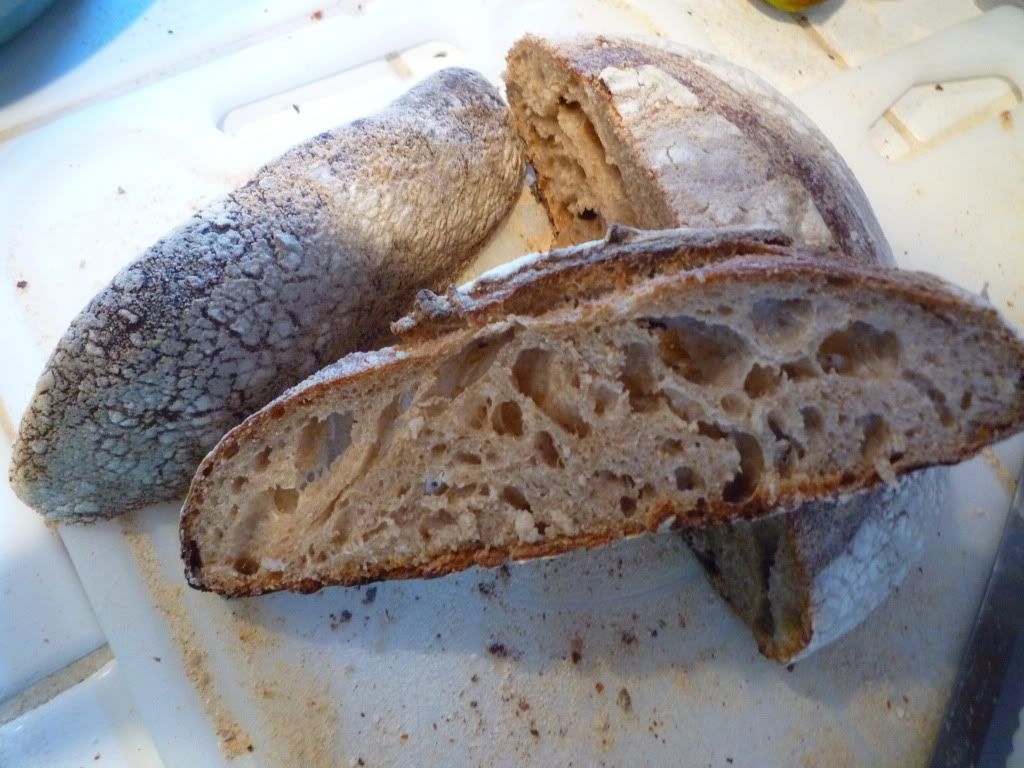 |
| My Most Aesthetic Bread Yet |
I made some bread today for our Downton Abbey picnic. It was absolutely fantastic. I realized that by refreshing the wild yeast a few hours before using putting it into the starter in the bread recipe, it gives the bread that amazing sweet flavor with no sweeteners of any kind. It was far too tempting-- we ate the whole first loaf between the three of us tonight.
I wanted to put this up on Yeast Spotting so I decided to repost the recipe. It can also be found on my original post, A New Sourdough, and on my Recipe Page.
Ingredients:
Starter
- 56.5g 100% hydration starter
- 227g Whole Wheat Flour
- 150g Water, room temperature
- All of the starter
- 445g Water (warm)
- 567g Unbleached Bread Flour (I used a combination of bread flour and-- when I ran out of that-- a high-protein all-purpose flour-- King Arthur's)
- 18g Salt
Starter (Day 1)
- Mix the ingredients for the starter together about 8 hours befor you plan to use it.
- Make sure you mix it with a for or something that will help incorporate a little air.
- Cover the bowl or jar and leave it to mature overnight at room temperature. Otherwise, the starter can rest in the refrigerator for up to three days.
- The starter, by now, should be all bubbly and smell slightly sweet.
- Dissolve the starter in the water.
- Then add the unbleached flour and the salt and mix into tacky ball. Let the dough rest for five minutes.
- The knead the dough by hand for 3 minutes. Try to incorporate air.
- Then do the first Peter Reinhart stretch-and-fold. Do four total with 10 minutes in between each.
- Depending on how warm your kitchen is, let the dough rest out (covered) for 1.5-2 hours before placing in the refrigerator. It was about 75 degrees in my kitchen and I let the dough sit out for 2 hours. Place it in the refrigerator overnight.
- Take the bread out of the refrigerator 5-6 hours before baking. Let it rest on at room temperature for 2-3 hours, depending upon the room temperature. The bread was still very cold at 2 hours, so I waited the extra hour.
- Then turn the dough onto a lightly floured surface and divide it. It can make two 1.5lb loaves or three 1lb loaves. Preshape.
- Let the dough rest for 20-30 minutes, and then do the final shaping. Cover the loaves and let them rise for 2.5-4 hours. My loaves needed three hours. The first loaf we baked after two hours and I think that it could have used a little extra rising time, while the second one we baked at three hours and it turned out better.
- 20 minutes before baking, heat up the your oven with your stone-and-broth-pot or dutch oven to 500 degrees F.
- Turn your dough onto a floured peel and score it right before you put it into the oven. Turn the oven down to 450 degrees F (425 convection).
- Let the dough bake under steam for 30-35 minutes, making sure that the edges of your scoring marks have turned golden.
- Then bake it for 20-25 minutes without steam, ensuring that it has an internal temperature of 212 degrees. It should be fairly light in weight and dark brown in color.
- Wait at least 30 minutes before slicing.
It was absolutely fantastic. One or two notes:
First, I've been using parchment on the dough as I slide it into the oven. It take the parchment paper off the bottom when I take the bread out from under steam. The reason that I've been doing this is twofold. First, sometimes my breads stick to the peel a little and stretch as I slide them into the oven. This does not happen with the parchment paper. Second, it means there is less flour that burns in the oven that I have to clean up later.

Looks amazing. I forgot to watch last night. The picnics sound like a great tradition.
ReplyDelete